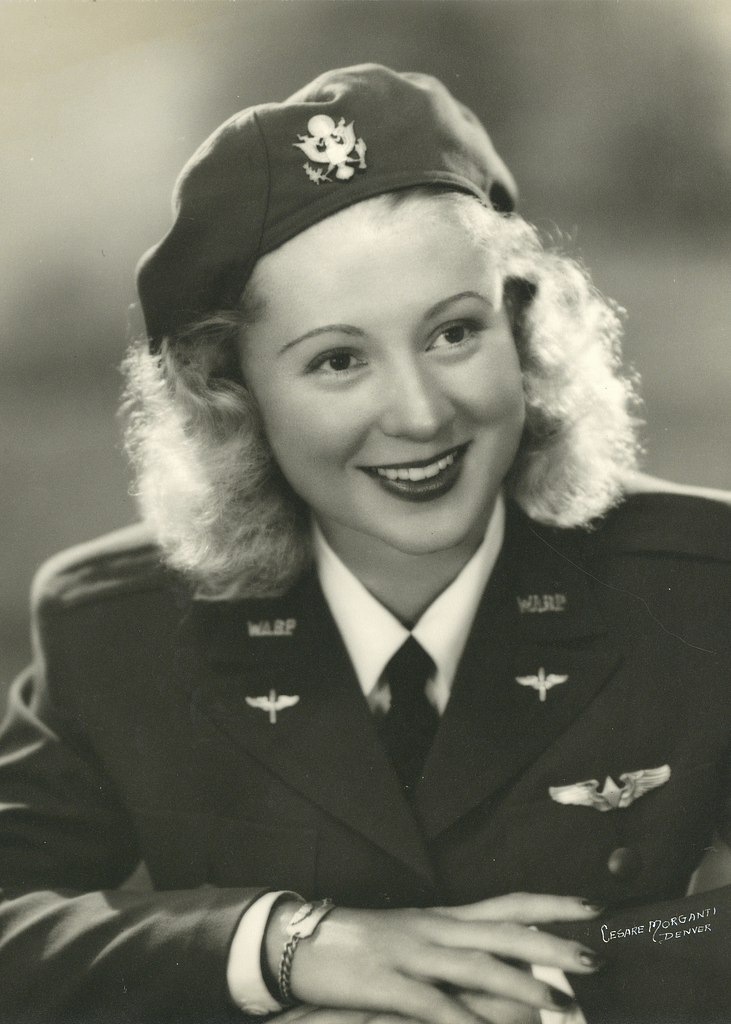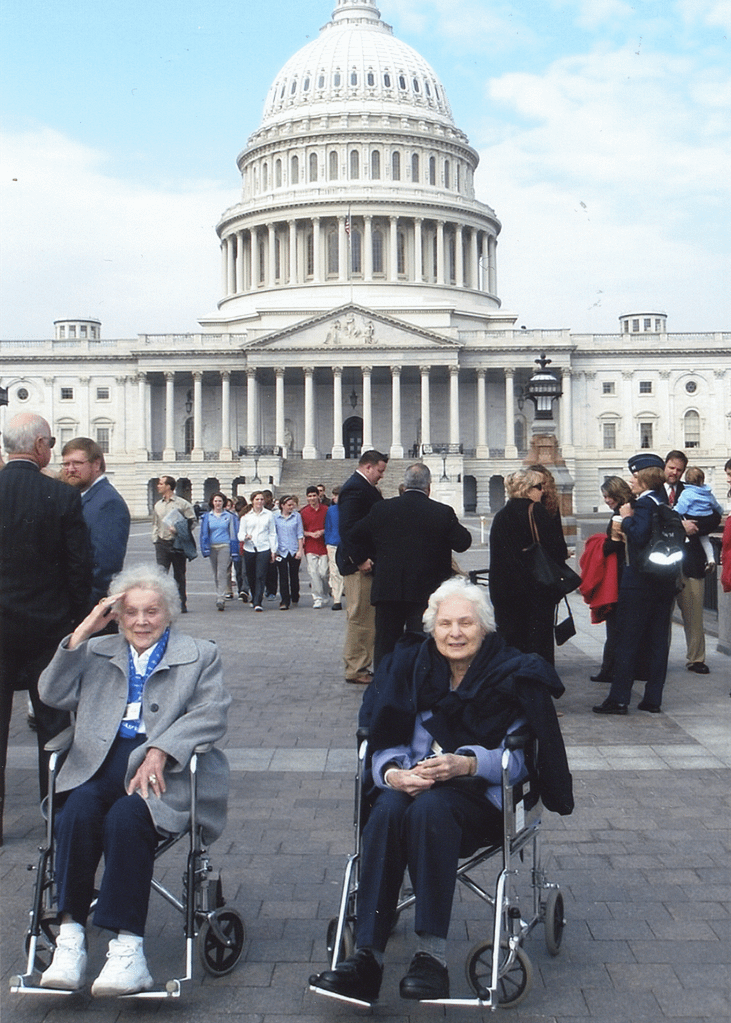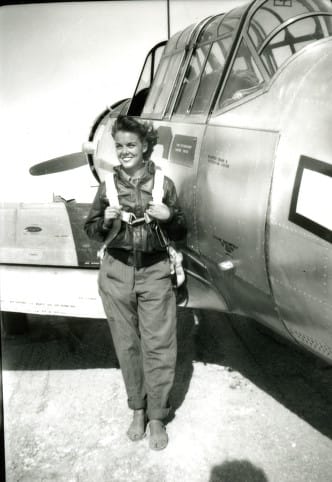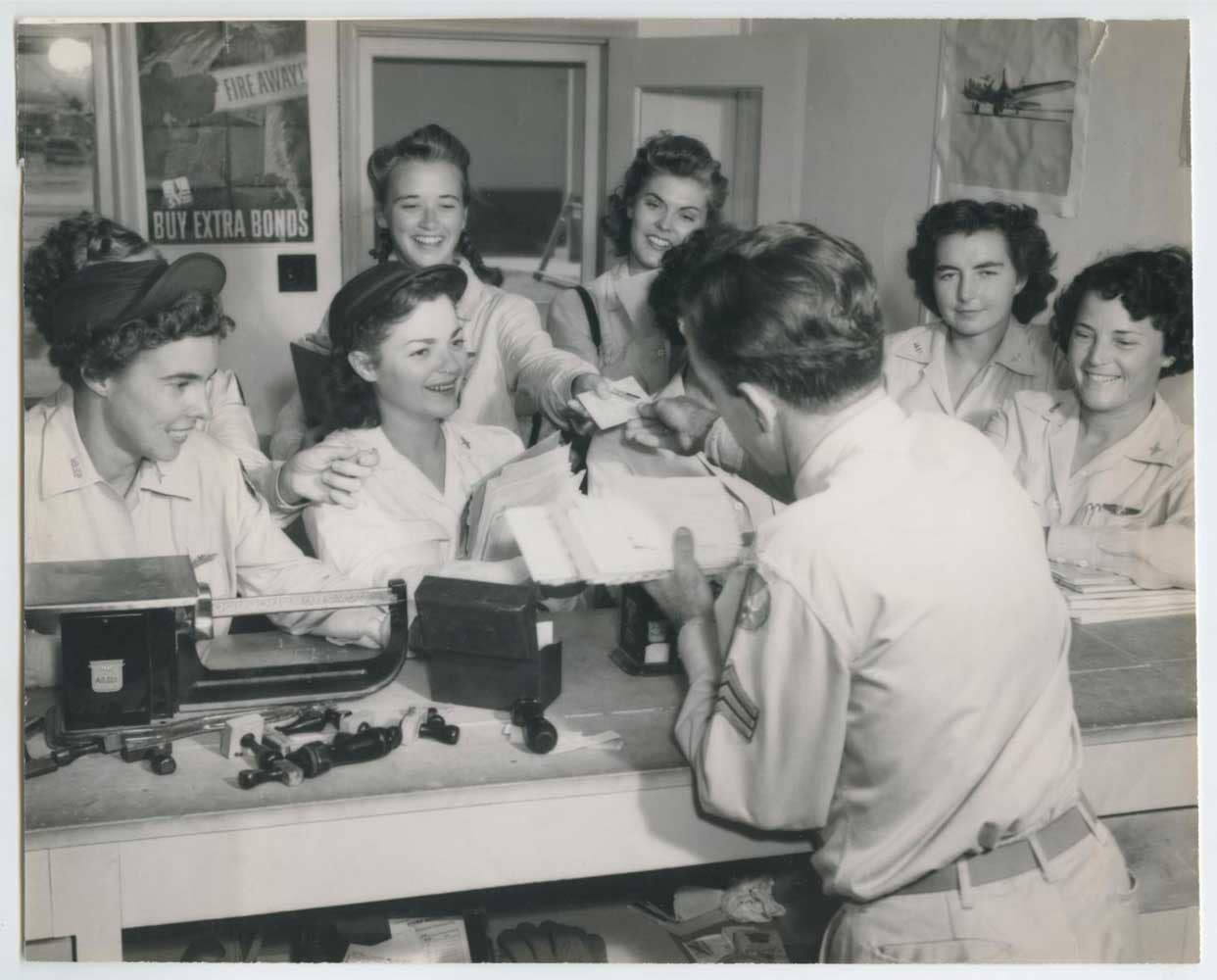
On Saturday, April 27, 2024, at the Homecoming Celebration & Airshow, the WASP Museum unveiled its new collection of special WASP in the Spotlight exhibits for the 2024-2025 year. Much like a patchwork quilt, the individual stories of the WASP, pieced together, create the beautiful larger narrative of the WASP program. This quilt represents the most complete account of these mighty pilots and their WASP program.
Family members of two WASP represented in this exhibit were panelists at our WASP Celebration Brunch where they were able to speak to their mother’s spirits, adventures, and accomplishments, among the crowd of WASP families in attendance.
To read their stories and experience this exhibit, please come to the Museum to see their collections before April 2025.
DONATE ARTIFACTS WITH CONFIDENCE
Many of you have inquired about your WASP becoming a Spotlight honoree. Please know while our aim is to spotlight all the WASP either physically and/or digitally, the archive needs information to tell their stories.
An archive is the lifeblood of any museum. It provides primary sources of information through newspapers clippings, official documents, photographs, and textiles that are needed to tell historically accurate, fascinating, and engaging stories. Families can donate artifacts to the Museum with confidence. The National WASP WWII Museum Archive, the only organization solely dedicated to the WASP, adheres to the National Archives and Records Administration (NARA) Archival Storage Standards in our vault’s construction and in the archival materials used for preservation.

Please contact Ann Haub at ann@waspmuseum.org to donate artifacts, request research assistance, or to tour the archive.
CURRENTLY ON DISPLAY


Rosa Lea Fullwood Meek Dickerson 43-W-4
Rosa Lea was born March 20, 1922, in Hereford, Texas to Walter and Buna Fullwood. Her father “Pop” owned and operated Fullwood’s Flying School and taught Rosa Lea and her brother to fly at an early age. Rosa Lea soloed unofficially when she was approximately 12 years old. She graduated from McAllen High School in 1939 and McAllen Business College in 1941 and worked as an office manager for her father’s flying school from 1939 through 1943. In 1940 at age 18 she qualified for her private pilot license and qualified for her Commercial Pilot’s License in 1942.
At age 20 with over 200 hours of flight time, Rosa Lea applied and was accepted into the Women Airforce Service Pilots training program class 43-W-4 on February 15, 1943, at Avenger Field Sweetwater, Texas. After graduating from training on August 7, 1943, she was assigned to Love Field 5th Ferrying Group, Dallas, Texas as a Ferry Pilot flying Army Air Force Military aircraft. She flew P-39, P-63, P-47, P-40, and P-51 pursuit planes until the WASP disbanded on December 20, 1944. The P-51 Mustang was her favorite plane.
On March 13, 1945, Rosa Lea married Carl D. Meek, Sr, her hometown friend from McAllen, Texas. They had two children, Janet and Carl Jr. She and Carl Sr. bought out Mr. W.C. Fawcett’s interest in the “Kerrville Flying School” in Kerrville, Texas, and operated the Airport, Flying School, and Maintenance Department from 1945 to 1950. After selling the airport operations they bought the Lincoln and Mercury automobile franchise in Kerrville. Five years later, they sold the automobile franchise and opened a real estate brokerage business known as Meek Real Estate. The Real Estate business was very successful for both Carl Sr. and Rosa Lea even after their divorce in 1967.
Rosa Lea married Arthur Dickerson in August 1988 in Kerrville, Texas. They enjoyed 12 years together RVing, Square dancing, and Ballroom dancing. After Arthur’s death, Rosa Lea remained involved in Real Estate managing and developing some of her properties.
Solange D’Hooghe 43-W-5
Solange Marie D’Hooghe was born July 13, 1915 in Chicago Illinois to Joseph D’Hooghe and Marie Rosalie Dewunck D’Hooghe. Joseph (Joe) and Marie met in Temise Belgium at the Vliegweek air show. Marie longed to learn to fly and dared to go up in one of France’s airplanes. Her ambition was tamped down by the town matriarchs who thought it “unseemly” for a woman to pilot a plane. Joe and Marie married and traveled to America for their honeymoon. While crossing the Atlantic, German forces occupied Joseph’s hometown of Niel, Belgium, causing his mother Eugenie to cable them not to return until after the war. They never returned.
Solange was born in Chicago in 1915 and moved with her family to Rockford, Illinois in 1917 across the street from what became Machesney Field in 1927. She graduated from Muldoon High School and attended the College of St. Teresa at Winona, Minnesota, and Rockford College. While at Rockford College she was a member of the Catholic Woman’s League and employed in the civilian personnel office at Camp Grant. In 1935, Solange developed her interest in aviation through the Junior Birdmen, a club created by Hearst Newspapers, to boost junior interest in flying by building model airplanes. She learned to fly at Machesney airport, where she earned her private pilot’s license and was active in the CAP. Solange aspired to be a commercial pilot which required 200 hours of flight time, a wide knowledge of navigation, meteorology, and flying regulations. The CAP course enabled her to earn her private pilot’s license in 1942. Solange purchased a used Aeronca two-seat plane. She applied for and was accepted into the Woman’s Flying Training Detachment (WFTD) at Avenger Field, Sweetwater, Texas on March 23, 1943. The WFTD and the Women Auxiliary Ferrying Squadron (WAFS) merged in August 1943 to become Women Airforce Service Pilots (WASP). Solange’s class 43-w-5 graduated September 11, 1943, and she was assigned to Romulus Michigan Army Air Field outside Detroit as a ferry pilot. Solange’s eardrum burst on a hop, and she was grounded. However, she continued to work for the Romulus squadron in the office of Pilot Flow from 1943 to 1944. The WASP program was deactivated on December 20, 1944. In early 1945 Romulus closed. Solange and her family decided to move to California but made it as far as Las Vegas, Nevada. They lived out their lives in the once-sleepy stagecoach stop called the Meadows (Las Vega in Spanish).
Solange began a 50-year career as a licensed Realtor and a member of the social sorority Beta Sigma Phi. She was a charter member of the Las Vagas chapter of the 99’s in the late 1940s and the first woman on the Clark County Commission’s Aviation Committee overseeing airport operations and expansion.




Dori Marland Martin 43-W-8
Dori Marie Jugle was born in Philadelphia, Pennsylvania on November 1, 1921, to Richard Marland Jugle and Marie Henkel Jugle. Her father was President of ABCO Ball Mill a mining machinery company. The family traveled back and forth from Pennsylvania and Colorado, as a result, Dori never stayed longer than two years in one school. Between elementary and high school she skipped three grades. School officials did not want her to graduate too early so they suggested she be kept out of school each time she advanced a grade. During her time off Dori fell in love with horses and at age fourteen, she became a champion rider on her horse, ‘Firebird’. She rode in the hunting, jumping, bareback, and English categories and was a three-time Colorado State Champion before she was eighteen. Eventually, the family moved to Chicago where Dori spent her last two years of high school, swimming with the Lake Shore A.C. Water Ballet Team. After graduation in August 1940, Dori won the Catalina Swimsuits National Competition for the “Most Beautiful Figure.” The prize included a trip to California, where she enrolled as a full-time student at the Pasadena Playhouse. She took her father’s middle name as her official stage name and became Dori Marland. She spent two years learning to act while working at Paramount Pictures.
After America was attacked at Pearl Harbor, Dori wanted to help the war effort. Her father told her about a training program for women pilots to fly for the Army Air Forces. She immediately returned to Denver and began taking flying lessons from two boyfriends, Captains with Continental Air Lines. Once she met the requirements she applied, interviewed, and was accepted to the WASP training program at Avenger Field in Sweetwater, Texas in July 1943. After graduating with class 43-W-8 she was assigned to Douglas Army Air Field, Arizona where she was an engineering test pilot and administrative pilot for Generals “who wanted to see things.” While at Douglas, she was sent on temporary assignment to Orlando, Florida, where she completed the officer’s training program. Eventually, she was transferred from Douglas to Kingman, Arizona, and completed B-26 transition training, and towed targets for air-to-air gunnery practice. After the WASP disbanded, Dori returned to Denver and took a job modeling designer fashion and began touring with an acting company, performing at air bases in the Rocky Mountain Region. Eventually, she moved back to California where she took a modeling job at I. Magnin & Co. which included modeling hats for magazine ads. Dori married Johnny F. Martin, Chief Test Pilot for Douglas Aircraft and they moved to Beverly Hills where they enjoyed the Hollywood lifestyle. Dori became a stay-at-home mom, den mother, and little league cheerleader for her two young sons, Richard Joseph and Michael James.
From horsewoman to Hollywood starlet, to WASP, Dori Marland Martin was truly one-of-a-kind. Forever the ingenue, this actress, model, horsewoman, and pilot was a true patriot. She could have stayed in Hollywood and ‘acted’ her way through World War II. Instead, she learned to fly so that she could serve her country as a WASP. She dined at the finest Sunset Strip restaurants and lived in the hills overlooking Hollywood, she modeled mink coats and ostrich feathered hats, and she flew the B-26 bomber–nicknamed the ‘Widowmaker.‘ Her life was a testament to patriotism, hard work, persistence, and turning set-backs into step-ups. When she needed to, she made her way through, and she always did it with a smile.
WASP Final Flight
Marylyn Myers Peyton 44-W-5
Marylyn Myers was born in Kansas City, Missouri, on February 25, 1924, to Gaylord W. Myers and Mary B. Scoggins Myers. She grew up in Lawrence, Kansas, and then in Des Moines, Iowa. She left high school to work for United Airlines in Des Moines as a flight agent, and to take flying lessons. Marylyn said “I just put my money into flying lessons. Because I just felt in my heart that sooner or later they would have to rely on girls. …flying is just – you LOVE it. Irregardless of what kind of an airplane you are in.”
In 1942, she became a licensed pilot and a member of the Civil Air Patrol. Marylyn wanted to contribute to the war effort as a pilot. She took the train from Des Moines, Iowa to Wichita, Kansas to try to find the WASP enlistment site, but was unable to do so. Disappointed, she took a cab and was told by the cab driver where the women pilots were enlisting. She enrolled and in December 1943 she was accepted to the Women Airforce Service Pilots (WASP)training program at Avenger Field in Sweetwater, Texas. After seven months of rigorous training, Marylyn graduated with class 44-W-5 on June 27, 1944, and served as a test pilot stationed in Pecos, Texas. Test pilots flew planes with reported defects to determine what needed to be fixed, and those that had been repaired, to check them out. She was also a flight instructor and ferried officers from base to base when needed.
While stationed at Pecos AAB, Texas, Marylyn met Charles F. Holcomb, an Army Air Corps pilot. They married in September 1944, before he shipped out to Europe. The WASP were disbanded on December 20, 1944. Marylyn and Charles had one child, Cathy, in July 1945. After an early wartime divorce, Marylyn raised Cathy as a single mother in Denver, Colorado. She was drawn to aviation and worked in meteorology at United Air Lines for several years. She married William J. Peyton, Jr. (Bill) in 1962 in Denver, Colorado. He was an FBI agent in Denver, and a Veterans Administration attorney in Fresno, California.
Marylyn and Bill were happily married for 40 years. They enjoyed retirement in Colorado and Arizona, loved to travel in their Winnebago, and danced to Big Band and swing music. They were both tall, and their heads could be seen above the crowd. They especially enjoyed their time in the Rocky Mountains, where Bill was a seasonal ranger.


She and Bill helped organize WASP reunions, provided a videotaped interview for the Library of Congress’ Veterans History Project, and supported the National WASP WWII Museum. Bill died in 2002.
On March 2010, Congress presented the surviving WASP and representatives of those deceased, with the Congressional Gold Medal. Marylyn’s family accompanied her and another WASP (Dori Marland 43-W-8) to Washington D.C. to receive the medal.
Marylyn remembered the thrill of flying to the end, She was always a sky-watcher and enjoyed identifying the clouds and watching the weather.


Betty Jo Streff Reed 44-W-7
Betty Jo was born on June 20, 1923, in Sherman, Texas to Nellie and John N. Streff. As a 2-year-old the family moved to Des Plaines, Illinois. Betty called Des Plaines her home until 1948 when she married Carl W. Reed. At age four, Betty Jo would sit in her Daddy’s lap and share his interest in the latest news, often reading about Charles Lindbergh and his trip across the ocean. From then on, every time she would hear an airplane fly over the house, she would run outside and yell “Hi, Lindbergh!”. For her sixth birthday, the family took a ride in a Ford Tri-Motor at the Curtis-Reynolds Airport Airshow. Her Father paid $1 for the flight. It was “love at first flight! “I remember feeling free and happy and loving the whole experience. From then on, I knew that I wanted to fly.” Betty Jo never stopped thinking about airplanes, December 7, 1941, WAR! Betty Jo graduated in June of 1942 and decided to pursue her first love and do her part in the war effort, hopefully including aviation. November 12, 1942, she took her first flight lesson on ski’s in a J-3 Cub at the Pal-Waukee Airport. She was being paid $18.50 per week working at Marshall Fields and spent $9.00 per hour for flight instruction.
Early in 1943, Betty Jo was hired by Douglas Aircraft to work in the tooling department until the plant was built. She ultimately ended up in cockpit installation. She saw the July 1943 issue of Life Magazine and on the cover was a beautiful gal in a military flight suit on the wing of a military airplane. Oh WOW, she was so excited! Betty Jo contacted Jacqueline Cochran and an interview was set up for September. She passed the required qualifications and physical and joined WASP class 44-7 on February 2, 1944, at Avenger Field Sweetwater, Texas. Betty Jo described herself as “tall and skinny,’ when she entered training. On the first day, one of her classmates affectionately gave her the nickname, ‘Birdlegs.’ The nickname stayed with her throughout her life. She graduated and received her silver wings on September 8, 1944, and was assigned to the Eastern Training Command, Columbus Army Air Field, Columbus, Mississippi as an engineering test pilot. On December 20, 1944, when the WASP were disbanded, Betty Jo paid her way back home and returned to a job at the Douglas C-54 plant as a mechanic in the hangar and eventually as a dispatcher. Douglas Aircraft was turning out many C-54’s for the Army Air Corp and Navy. Col. A.R. Holiday was the acceptance officer for the military and needed two co-pilots. Betty and Ellen Wimberly accepted the challenge, she got her chance to check out on the C-54. The big thrill of her life was to go from her first job as a file clerk to co-pilot of the big 4-engine Transport.
When an automobile accident temporarily grounded her, Betty Jo married Carl W. Reed and they were blessed with two boys and two girls. In 1957, Carl and Betty opened the first McDonald’s franchise in Colorado- which was the third McDonald’s in the US. A year after the birth of their fourth child, Betty Jo began flying again. She earned her rating to fly Lear Jets and King Air. As their family business grew to ten McDonald’s, she became a corporate pilot. She competed in six Powder Puff Derbies winning a “Best in Class” from Flying Magazine. She was a member of The Ninety-Nines, Inc., the Arizona Wing of The Commemorative Air Force, WMA (Women Military Aviators), and the Air Force Association. She served as President of the Phoenix Wing of the American Aviation Historical Society and docent at the Champlin Fighter Aircraft Museum in Mesa, Arizona. In 1999, Betty Jo was inducted into the International Forest of Friendship, and in 2020 she and her fellow WASP were awarded the Congressional Gold Medal for their pioneering military service during World War II.
Suzette VanDaell Douglas 44-W-10
Suzette was born on December 10, 1922, in Scarsdale New York to Paul Alphonse Henri VanDaell and Roselle Taylor VanDaell. Her paternal grandparents emigrated from Germany in the 1880s and were professors of language at Harvard. Suzette’s father was a fisherman/farmer, and her mother was from Harbour Grace, Newfoundland. She had two sisters Claire and Paula. Suzette and Paula often teamed up against Claire, their older sister. Paula and Suzette would remain close throughout their lives. The family lived at 18 Montrose Lane in Scarsdale, a rather well-to-do neighborhood and her father held seats on the New York Stock Exchange.
In 1942, Suzette graduated from Colby Jr. College in New London, New Hampshire near Dartmouth College, an Ivy League school for men only. She worked in the DCAC (athletic office) and sold tickets to sporting events. It was there she met her future husband, Henry Tom Douglas who was attending Dartmouth. When Tom enlisted as a Naval cadet for flight training, she became interested in becoming a pilot herself., She was very headstrong and believed if a man could do it, so could she. Suzette chose to be an active participant in the war effort. Earning her pilot’s license on her own, she tried a couple of times to enter the WASP program and was finally accepted into class 44-W-10 at Avenger Field Sweetwater, Texas on May 26, 1944, where she trained to fly military planes. Tom and Suzette became engaged during training before the WASP program disbanded on December 20, 1944. They were married on October 20, 1945, at Whidby Island, Washington while Tom was assigned as a naval officer in pilot training for the US Navy in Sagit, Washington. They moved around the country from Aurora, Ohio, to Glenshaw, Pennsylvania, and finally to Arlington Heights, Illinois, and had four children Chip, Paul, Nancy, and Scott. As her children grew, Suzette was an avid supporter of their athletics and activities. She and Tom loved to travel and visited many exotic places in Asia, Europe, and Africa. They also enjoyed sports together, winning many tennis and golf championships at Biltmore Country Club. After Tom died in 1990, Suzette continued her travels to places like Cape Cod, Florida, and Mexico. She started working again at the Rivers Trail Tennis Club and volunteered at the Arlington Heights Memorial Library. Suzette was an active WASP member attending class reunions, air shows, and other public WASP events such as the Congressional Gold Medal Ceremony in 2010.


Past WASP in the Spotlight Exhibits

Mary “Marty” Anna Martin Wyall 44-W-10 | WASP in the Spotlight 4-28-2023
Mary Anna Martin was born on January 24, 1922, in Liberty, Indiana to Reverend Sumner L. and Bernice Smith Martin. In 1939, she graduated from Shields High School in Seymour,

Dorothy A. Lucas 44-W-7 | WASP in the Spotlight 4-28-2023
Dorothy A. Lucas, born on December 4, 1922, in Norfolk, Virginia, was the youngest of four children. Despite the challenges of the Great Depression and her family’s constant relocations due

Gloria Heath 44-W-7 | WASP in the Spotlight 4-28-2023
Gloria Heath was born on May 7, 1922, in New York City to Royal Vale and Lillian Hart Heart. She graduated from The Putney School in 1939 and from Smith

Rosa Charlyne Creger 44-W-10 | WASP in the Spotlight 4-28-2023
Charlyne Creger was born on December 24, 1918, in Noble, Oklahoma to her parents, Charles and Rosa Creger. Her father worked as a blacksmith and played the Tennessee Bluegrass fiddle,

Shirley Chase Kruse 44-W-6 | WASP in the Spotlight 4-28-2023
Shirley Chase Kruse was born on June 22, 2022, in Kearny, New Jersey and grew up in Newark. Her father worked as a Wall Street Accountant, while her mother was

Nell “Mickey” Stevenson Bright 43-W-7 | WASP in the Spotlight 4-28-2023
Nell Stevenson was born on June 20, 1921, in Canyon, Texas. When she was eight years old, her father paid a dollar for her to ride in a World War

Margaret Peggy Kocher 43-W-6 | WASP in the Spotlight 10-1-2022
Margaret Peggy Kocher was born in Salem, Massachusetts in 1921 to Willard and Margaret Grishkin Helburn. She was the youngest of three children – two sons Nick and Peter, and

Dorothy Fulton Slinn WAFS | WASP in the Spotlight 5-4-2022
Dorothy Fulton was born October 14, 1918, in Ridgefield Park, New Jersey to Harry Leroy and Johanna Crystal Jensen Fulton. As a young child, Amelia Earhart was Dorothy’s heroine and

